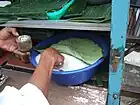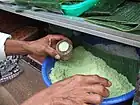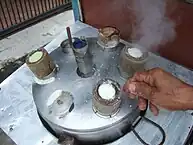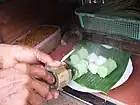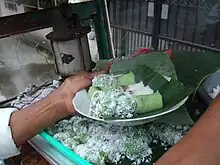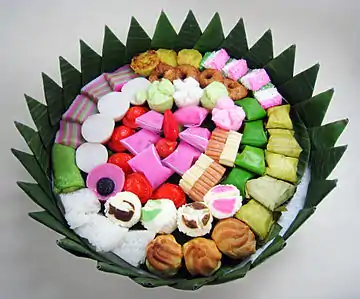Kue putu
Kue putu or putu bambu is an Indonesian kue.[1] It is made of rice flour called suji and coloured green with pandan leaves, filled with palm sugar, steamed in bamboo tubes (hence the name), and served with desiccated coconut. This traditional bite-sized snack is commonly found in maritime Southeast Asia, particularly in Java, Indonesia, where it is called putu bumbung. Kue putu is usually sold by street vendors and can be found in traditional markets, along with other kues. Kue putu can also be found in the Netherlands due to its colonial ties with Indonesia.[2]
 Kue Putu, filled with palm sugar and served with desiccated coconut. | |
| Alternative names | Putu bambu, putu bumbung |
|---|---|
| Type | Sweet dumpling |
| Course | Dessert, Snack |
| Place of origin | Indonesia |
| Region or state | East Java |
| Serving temperature | Room temperature |
| Main ingredients | Rice flour, palm sugar, coconut |
| Similar dishes | Puttu, puto, puto bumbong, kueh tutu, mache |
Ingredients and cooking method
It consists of rice flour with green pandan leaf colouring, filled with ground palm sugar. This green coconut-rice flour ingredients with palm sugar filling is filled into bamboo tube container. Subsequently, the filled bamboo tubes are steamed upon a steam cooker with small holes opening to blow the hot steam. The cooked tubular cakes then pushed out from the bamboo tube container, and served with grated coconut.
Etymology and variations

In Javanese, bumbung means "bamboo" or "a hollow cylindrical object; a tube". As the dish began to spread across the country, the name was later translated to Indonesian putu bambu (bambu: "bamboo"). Hence the name, as it is made by filling a bamboo tube with the ingredients (see the above picture).

Variations of kue putu are often in the shapes or fillings. Kue putu of different shapes with almost identical ingredients, fillings and recipes exist in Southeast Asia.
The white-colored, flatter disc-shaped putu is called putu piring (Malay for disc/plate putu) and is more common in Malaysia, Kerala and Sri Lanka, while thicker and more round white- or green-coloured putu mangkok (Indonesian for bowl putu) is found more in Indonesia. In Singapore, however, putu mangkok is called kueh tutu.
Traditionally kue putu is filled with palm sugar. Today, however, there are several new variations using different fillings, such as chocolate or abon (beef floss).[3]
Similar dishes
In the Philippines, puto is a generic name for any steamed rice cake. A type of puto very similar to kue putu is puto bumbong which is also cooked in bamboo tubes (bumbong in Tagalog). However puto bumbóng does not use pandan and is traditionally cooked as whole grains, rather than rice flour. It also uses a special purple variety of glutinous rice called pirurutong which gives it a deep purple colour.[4]
In India (Kerala, Tamil Nadu and Karnataka) and Sri Lanka, a similar dish is known as puttu or pittu, though the dessert variety is only predominant in Tamil Nadu.[5]
References
- Anggara Mahendra (13 June 2013). "'Kue Putu' Steamed Green Cake". Baily Daily. Archived from the original on 15 June 2015. Retrieved 12 June 2015.
- "Kue Putu Bambu". Waroeng. Retrieved 12 June 2015.
- Rusaidah (20 February 2012). "Kue Putu HJ Bangka Hadir dengan Tiga Pilihan Rasa" (in Indonesian). Bangka Pos. Retrieved 12 June 2015.
- Angelita M. del Mundo (1995). "Emerging Versions of Some Traditional Philippine Rice Food Products". In Harlan Walker (ed.). Disappearing Foods: Studies in Food and Dishes at Risk. Proceedings of the Oxford Symposium on Food and Cookery 1994. Prospect Books. p. 64. ISBN 9780907325628.
- Amy Besa & Romy Dorotan (2014). Memories of Philippine Kitchens. Abrams. ISBN 9781613128084. - BBC Indian Food Made Easy: Recipe for puttu, BBC, archived from the original on 24 December 2008, retrieved 13 August 2010
